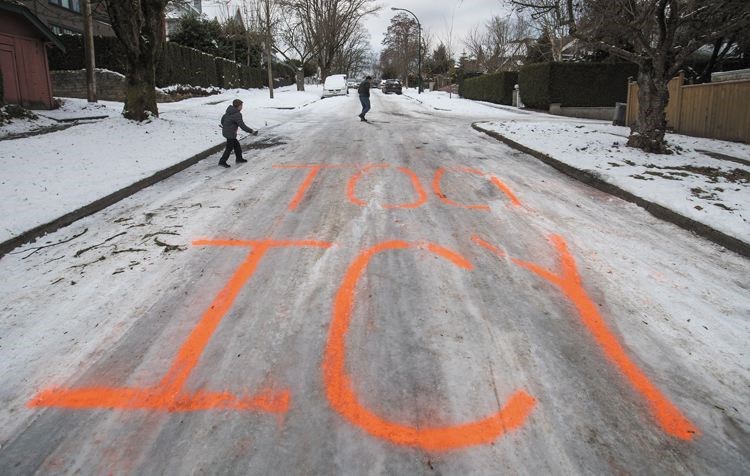Vancouverites have been in a mad rush to get salt as the city experiences a rare extended period of snow and icy weather. At one fire hall, there was a miniature riot as a pile of free salt was snapped up by area residents in only five minutes.
Thus B.C. has joined Canada's annual bacchanalia of salt. Literal mountains of the stuff are being dumped onto roads this winter, corroding cars, destroying shoes, withering crops and eating away at the very foundations of our towns and cities.
Salting allows us to drive 110 km/h on the highway in the depths of winter, but it may well be the most destructive peacetime government program in Canada.
Below, a summary of the price we pay for cheap de-icing.
It's doing billions of dollars in damage to cars
In 2015, the U.S. National Highway Traffic Safety Administration pegged salt corrosion as the culprit in thousands of vehicle brake failures. That same year, Transport Canada issued a recall of 3,000 BMWs and Minis that had been parked at the Port of Halifax during the 2015 ice storm. But it wasn't the ice that caused the recall; salt de-icing had damaged the vehicles so badly that they couldn't steer properly. Way back in 1975, Transport Canada estimated that de-icing salts were causing $200 in damage per car, per year - the equivalent of $854 in 2017.
Corrosion-resistant coatings have improved in the interim, but even when one-quarter that amount is applied to the roughly 14 million registered vehicles in Ontario and Quebec, the result is an extra $3 billion in vehicle depreciation each year.
It's ravaging our bridges and highways
Crews are already at work on a $4.2-billion replacement for Montreal's Champlain Bridge.
The original, built in 1962, was brought to the edge of collapse in only 50 years because of salt corrosion. Salt brine seeping into concrete dramatically speeds up the corrosion of rebar within - and is heavily responsible for the poor state of bridges and highway overpasses across central Canada.
Salt was a key contributor to the deadly 2006 collapse of the De La Concorde bridge in Laval, killing six people.
The heavy salt diet on Toronto's Gardiner Expressway is also one of the main reasons the elevated highway is often raining chunks of concrete; as rebar corrodes, the concrete around it crumbles. Tellingly, a series of 1930s-era stone carvings around Toronto's Air Canada Centre have been permanently ruined by salty runoff from the nearby expressway.
It's not just roads.
After the Algo Centre Mall in Ontario's Elliot Lake collapsed in 2012, killing two people, forensic analysts said the building's steel supports looked like they had spent decades marinating in sea water. There were structural problems, to be sure, but the building was also hammered by 30 years of salty runoff from a rooftop parking garage. Road salt was also a contributing factor to lead contamination of drinking water in Flint, Mich. Water from the Flint River - made extra salty by road salt runoff - was eating into old pipes, dosing the population with lead. In 2011, well before the Flint disaster, Michigan's Mackinac Center for Public Policy pegged the total damage done by road salt as high as $687 per tonne. In Minnesota, damage estimates ranged between $1,000 and $5,000 per tonne. Canada uses at least seven million tonnes of salt per year, according to 2009 estimates by Environment Canada.
Using the Mackinac Center estimate, that's $4.8 billion in damage per year - $1 billion more than the $3.6 billion damage caused by the Fort McMurray wildfire.
There's a bunch of small, annoying problems, too.
Dalhousie University estimated that it costs it an extra $15,000 in cleaning and maintenance each year just to repair all the damage salt does to floors and baseboards - with similar costs presumably accruing to most of Canada's other universities, museums and public buildings.
Salt severely corrodes leather, reducing the lifespan of Canadian shoes and requiring extra cleaning. And wading through salt is brutal on dogs' paws: every winter brings a new wave of chapped paw cases to Canadian vets.
Nature's not too happy with this, either
Hit a moose lately? There's a chance that they wandered onto the road in order to lick up some road salt. Sodium is quite rare in nature, which is why moose - like humans - have pretty strong salt cravings.
Much of Canada's road salts also end up on forest floors, farm fields or water systems. In 2010, a report found that Frenchman's Bay outside Pickering, Ont., was so polluted with road salt that it had been effectively cleared of fish.
There's a better way.
It's generally too cold for road salt to be effective in the Prairies, so municipalities make do with sand, plowing and - in residential areas - simply having people drive on packed snow. But, the Prairies also regularly rack up Canada's highest rates of highway deaths. Keeping roads ice-free is generally a good thing, but there are less-corrosive alternatives: calcium magnesium acetate, magnesium chloride and calcium chloride. But with salt costing only $50 per tonne, alternatives can cost between six to 18 times more. It's a lot of money for the already overstretched de-icing budgets of Canadian cities - but potentially a bargain when the total societal costs of salt are factored in.



